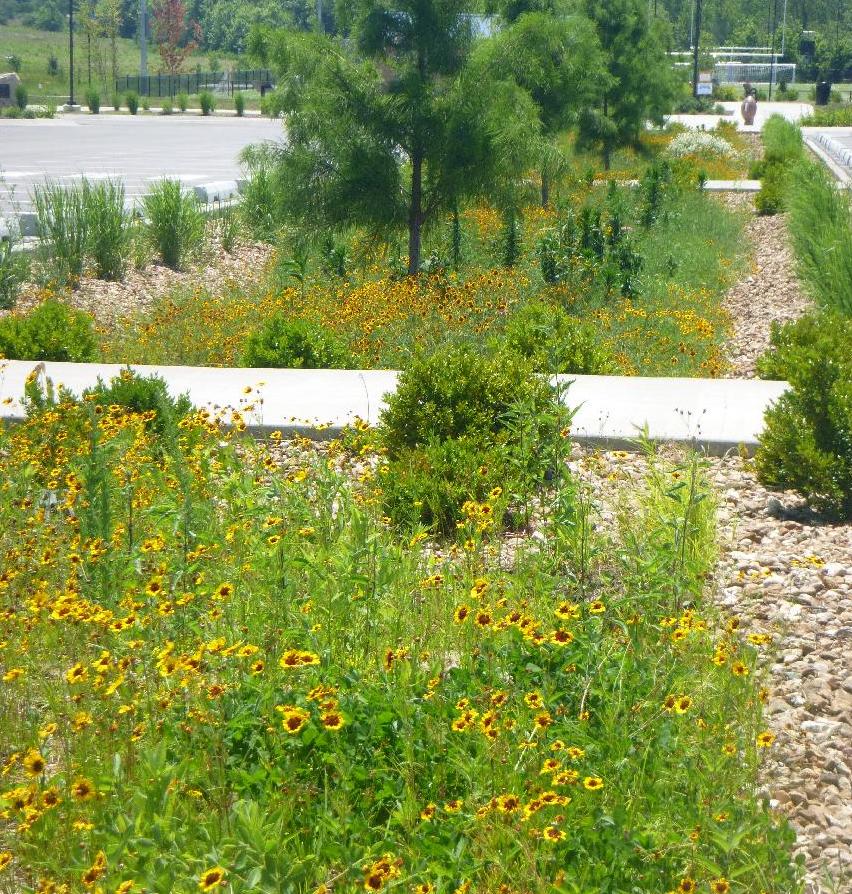Green Infrastructure Projects
Heartland Park Green Infrastructure

Green Infrastructure
Green Infrastructure uses the landscape (vegetation, soils, and natural processes) as infrastructure to manage water and provide a range of ecosystem services — clean air and water, flood protection and wildlife habitat. This approach to stormwater management mimics nature by soaking up and storing water. Green infrastructure is effective, economical, and enhances community safety and quality of life. It means planting trees and restoring wetlands, rather than constructing more pipes and expensive treatment systems.


Innovative Practices to Improve Water Quality
At Heartland Park, green elements such as rain gardens, wetlands, native meadows, riparian areas, pervious pavers, parking lot bioswales, and the wetland forebays help clean stormwater runoff before it gets to the seven-acre lake, which serves as flood control for 472 acres of drainage area. An interpretive trail and boardwalks at the wetland and lake help educate the public on the benefits of green infrastructure.
Try this Scavenger Hunt to find green features at the park.
Watch this video!
Pervious pavers and pavement captures stormwater and allows it to seep into the ground and recharge groundwater aquifers. Bioswales located in the parking lots also slow down and filter runoff. The wetland forebay helps keep the lake clean by collecting trash, soil, and debris before water reaches the lake.
What Is a Biofilter?
Biofiltration is a pollution control technique that uses plants, such as native Missouri wildflowers and grasses, to filter out pollutants from runoff water before it gets to the seven-acre lake. This also slows the water as it moves to the lake to help flood control. Biofilters are also known as rain gardens. There are approximately 2,500 trees, shrubs, and flowers planted at Heartland Park in biofilters, native meadows and for lake habitat to help filter and clean stormwater runoff.
Green infrastructure at Heartland Park was funded in part by a Section 319 Grant from US EPA Region 7 through the Missouri Department of Natural Resources under the Clean Water Act.
Law Enforcement Center Basin Gets a Facelift and New Purpose
Project Background
The storm drainage system at the Law Enforcement Center was designed to carry water from adjacent buildings and parking lots to a detention basin that provides flood control for downstream properties. Similar to most traditional stormwater facilities, concrete pipes and turf grass was used. As rain washes over these areas, it carries pollutants such as oil, metals, trash, and other auto fluids into the basin and directly into a stream that leads to Dry Branch Creek.
New Purpose
In 2011, the City worked with volunteers and students to convert this area into something more with the help of a grant from Department of Natural Resources. The purpose of the detention basin retrofit project was to control erosion and install over 500 native plants to help soak up rain and pollutants before the water leaves the site. The water flows over rocks and filter fabric, which helps slow the erosive power of runoff, and allows water to infiltrate into the soil where it recharges the groundwater system.
*Please note that this basin will be removed as part of the City Hall project. It still serves as a great demonstration of how common grounds and properties can use basins creatively.
LEC Biofilter Video Tour
Video tour showing the native plant biofilter project at the Law Enforcement Center in Wentzville, Missouri.
This project is partially funded by US EPA Region 7 through the Missouri Department of Natural Resources (Subgrant G11-NPS-07) under the Clean Water Act.
